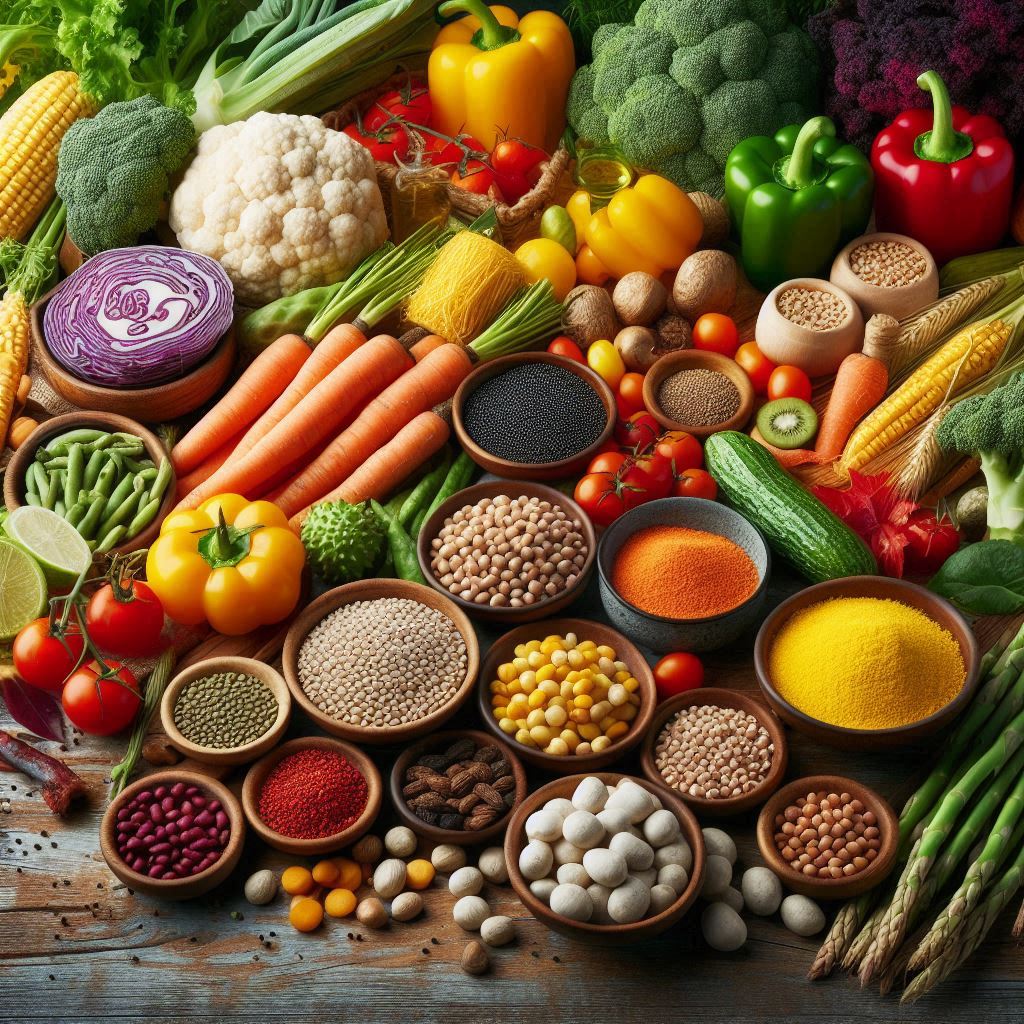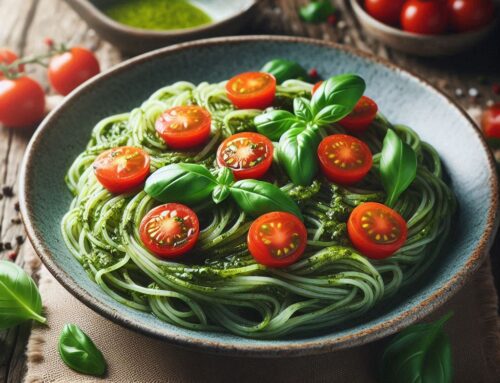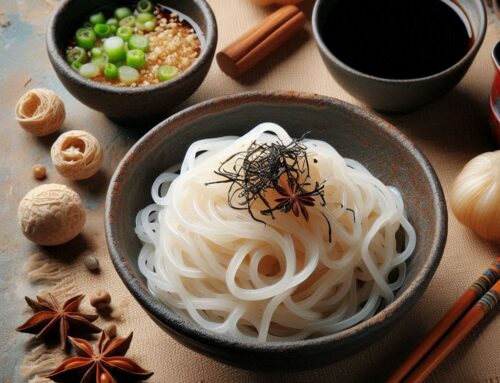
Introduction: Understanding Konjac Root and Its Culinary Uses
Konjac root, a staple in Asian cuisine, is gaining popularity worldwide for its unique culinary properties and health benefits. This remarkable tuber is the source of konjac noodles, also known as shirataki noodles, which have become a favorite among those seeking low-calorie and low-carb alternatives to traditional pasta. The magic ingredient in konjac root is glucomannan, a type of soluble fiber that not only aids digestion but also provides a satisfying texture in various dishes.
In plant-based cooking, konjac root offers versatility and innovation. Konjac noodles absorb the flavors of the ingredients they are cooked with, making them an excellent base for stir-fries, soups, and salads. Their ability to mimic the texture of conventional noodles without adding significant calories or carbohydrates makes them ideal for those looking to maintain or lose weight while enjoying hearty meals.
Understanding how to incorporate konjac root into your culinary repertoire can open up new possibilities for nutritious and creative dishes. Whether you’re exploring vegan recipes or simply aiming to diversify your diet with plant-based options, konjac root provides an exciting ingredient that aligns with modern dietary preferences.
The Nutritional Profile of Konjac Root and Why You Might Seek Alternatives
Konjac root, often hailed for its impressive nutritional profile, has become a popular choice among health-conscious individuals seeking low-calorie and gluten-free alternatives. One of the standout features of konjac nutrition is its high content of dietary fiber, specifically glucomannan. This water-soluble fiber can absorb large amounts of water, expanding in the stomach to promote a feeling of fullness with minimal caloric intake. Consequently, konjac-based products like shirataki noodles have gained traction as effective tools for weight management.
However, while konjac root offers these benefits, it may not be suitable for everyone. Some individuals experience digestive discomfort due to its high fiber content or find the texture and taste unappealing. Additionally, those with specific dietary restrictions or allergies might need to explore alternatives that align better with their nutritional needs.
Fortunately, there are numerous substitutes available that provide similar benefits without compromising on taste or texture. For instance, zucchini noodles offer a fresh and nutritious option rich in vitamins while maintaining a low calorie count. Cauliflower rice is another versatile alternative that fits well into gluten-free diets and adds a subtle flavor to meals.
Understanding the nutritional profile of konjac root helps consumers make informed decisions about incorporating it into their diet or exploring other options that meet their health goals more effectively.
Top Plant-Based Substitutes for Konjac Root You Should Try
Zucchini Noodles (Zoodles)
When it comes to plant-based substitutes for konjac root, zucchini noodles, or “zoodles,” stand out as a versatile and nutritious alternative. These spiralized strands of zucchini offer a similar texture to traditional pasta, making them an excellent choice for those seeking a low-carb, gluten-free option. Zoodles are not only simple to prepare but also rich in vitamins and minerals like vitamin C, vitamin A, and potassium.
Zucchini noodles can be used in a variety of dishes—whether you’re looking to create a refreshing cold salad or a warm, hearty meal. They pair beautifully with an array of sauces and toppings, from classic marinara to creamy pesto. Additionally, zoodles cook quickly; just a few minutes in the pan or even raw if you prefer them crisp.
Beyond their culinary flexibility, zucchini noodles are celebrated for their health benefits. As they are primarily composed of water and fiber, zoodles can aid in digestion while keeping you hydrated. Their low-calorie content makes them ideal for weight management without sacrificing flavor or satisfaction.
Incorporating zucchini noodles into your diet is not only easy but also opens up new avenues for creativity in the kitchen. Whether you’re new to plant-based eating or simply exploring different options beyond konjac root, zoodles provide an appetizing way to enjoy your favorite meals with added nutritional benefits.
Cucumber Noodles
When exploring plant-based substitutes for konjac root, cucumber noodles stand out as a refreshing and versatile option. Known for their hydrating properties and crunchy texture, cucumber noodles are an excellent alternative for those seeking a low-calorie, nutrient-rich ingredient in their meals.
Cucumber noodles can be easily prepared using a spiralizer or vegetable peeler to create long, thin strands that mimic traditional pasta. This makes them an ideal base for salads, stir-fries, or even as a substitute in your favorite noodle dishes. Not only do they offer a satisfying crunch, but they also pair well with a variety of sauces and seasonings due to their mild flavor.
In addition to being low in calories, cucumbers are packed with vitamins such as vitamin K and C and provide essential minerals like potassium. Their high water content also aids in hydration, making them perfect for hot summer days or post-workout meals.
Whether you’re looking to reduce your carb intake or simply want to incorporate more vegetables into your diet, cucumber noodles offer a delicious and healthful alternative to konjac root that you should definitely try.
Cabbage Strips
When it comes to finding plant-based substitutes for konjac root, one versatile option that stands out is cabbage strips. Cabbage, a common and widely available vegetable, offers a range of benefits that make it an excellent alternative. Its naturally mild flavor and satisfying crunch can mimic the texture of konjac in various dishes, making it an ideal substitute for those seeking variety in their plant-based diet.
Cabbage strips are incredibly easy to prepare. Simply slice fresh cabbage into thin strips and use them as you would konjac noodles or rice. This substitute works well in stir-fries, soups, salads, and even as a base for hearty sauces. Additionally, cabbage is rich in essential nutrients such as vitamin C and fiber, contributing to a balanced diet while offering a low-calorie option.
Moreover, using cabbage strips can enhance the overall nutritional profile of your meals without compromising on taste or texture. Whether you’re looking to diversify your plant-based options or simply want to try something new and healthful, incorporating cabbage strips into your culinary repertoire is definitely worth considering.
Seaweed Noodles (Kelp Noodles)
When exploring plant-based substitutes for konjac root, seaweed noodles, also known as kelp noodles, emerge as a fascinating alternative. These translucent noodles are derived from edible brown seaweed and are renowned for their unique texture and nutritional benefits. Unlike traditional pasta, seaweed noodles are low in calories and carbohydrates, making them an excellent choice for those seeking a lighter meal option.
Seaweed noodles stand out not only for their health benefits but also for their versatility in the kitchen. They absorb flavors well and can be easily incorporated into a variety of dishes—from salads to stir-fries—offering a delightful crunch that enhances the overall dining experience. Furthermore, they are rich in iodine, an essential nutrient that supports thyroid function.
For individuals looking to diversify their plant-based diet or reduce calorie intake without sacrificing taste or texture, seaweed noodles present an exciting culinary adventure. Their ease of preparation and adaptability make them a must-try substitute for konjac root in any health-conscious kitchen.
Soybean Pasta (Edamame or Black Bean)
For those exploring plant-based alternatives to konjac root, soybean pasta, made from edamame or black beans, offers a nutritious and satisfying option. Soybean pasta is not only rich in protein but also packed with fiber, making it an excellent choice for those seeking a wholesome meal that aligns with dietary preferences.
Edamame pasta retains the vibrant green hue of young soybeans and delivers a mild, nutty flavor that pairs well with various sauces and vegetables. On the other hand, black bean pasta provides a striking dark color and a heartier taste profile, perfect for robust dishes.
Both types of soybean pasta are gluten-free and lower in carbohydrates compared to traditional wheat-based pastas. This makes them ideal for individuals following low-carb or gluten-free diets while still craving the texture and versatility of conventional noodles.
Incorporating soybean pasta into your meals is simple—just cook it like regular pasta and enjoy it in salads, stir-fries, or classic Italian-style dishes. With its health benefits and culinary flexibility, soybean pasta serves as an excellent substitute for konjac root in any plant-based kitchen.
Culinary Tips for Cooking and Flavoring Plant-Based Alternatives to Konjac Root Dishes
When it comes to plant-based cooking, finding suitable substitutes for konjac root dishes can open up a world of culinary possibilities. Konjac root, known for its low-calorie and high-fiber content, is often used in dishes like shirataki noodles and gelatinous desserts. However, there are numerous plant-based alternatives that can mimic its texture and flavor while adding their own unique twist.
First on the list of substitutes are zucchini noodles or “zoodles.” These spiralized vegetables offer a similar texture to konjac noodles but come with additional nutrients such as vitamin C and potassium. To enhance their flavor, consider lightly sautéing them with garlic and olive oil before adding your favorite sauce.
For those looking to replicate the gelatinous quality of konjac in desserts, agar-agar is an excellent option. Derived from seaweed, agar-agar sets more firmly than traditional gelatin and works well in jellies and puddings. It’s important to note that agar-agar requires boiling to dissolve properly; thus, following package instructions is key for achieving the desired consistency.
Mushrooms also serve as a versatile substitute due to their umami-rich profile. When sliced thinly or diced finely, mushrooms can add depth of flavor to soups or stir-fries that traditionally use konjac products. Marinating them beforehand can further enhance their taste while ensuring they absorb surrounding flavors during cooking.
Finally, when seeking plant-based recipes tips for these alternatives, experimentation is your best friend. Don’t hesitate to try different seasonings like nutritional yeast or smoked paprika to elevate the dish’s complexity. By exploring these substitutes and techniques, you’ll not only diversify your culinary repertoire but also create delicious meals that cater to various dietary preferences without sacrificing taste or texture.
The Environmental Impact of Choosing Sustainable Plant-Based Alternatives Over Traditional Ingredients
In recent years, the conversation around sustainable eating habits has gained significant traction, as more individuals become aware of the environmental impact of their food choices. Opting for plant-based alternatives over traditional ingredients is a powerful way to embrace environmentally friendly food choices and contribute to a healthier planet.
One of the primary benefits of choosing plant-based options is the reduction in carbon footprint associated with diet. Traditional meat and dairy production are major contributors to greenhouse gas emissions, deforestation, and water usage. By contrast, plant-based foods generally require fewer resources and produce lower emissions. For instance, producing a kilogram of beef can generate up to 60 kilograms of greenhouse gases, while tofu only produces around 3 kilograms for the same amount.
Moreover, sustainable eating habits often involve selecting locally-sourced and seasonal produce, which further minimizes transportation-related emissions. This not only supports local farmers but also reduces the overall carbon footprint of your meals.
By incorporating more plant-based alternatives into our diets—such as legumes, grains, nuts, seeds, fruits, and vegetables—we can make significant strides in reducing our environmental impact. Embracing these changes doesn’t mean giving up favorite dishes; instead, it’s about finding creative ways to enjoy delicious meals that are both satisfying and sustainable.
Ultimately, making environmentally friendly food choices is about considering the broader implications of what we eat on our planet’s health. By consciously opting for sustainable plant-based alternatives over traditional ingredients whenever possible, we take an essential step towards preserving natural resources for future generations while enjoying diverse culinary experiences today.






